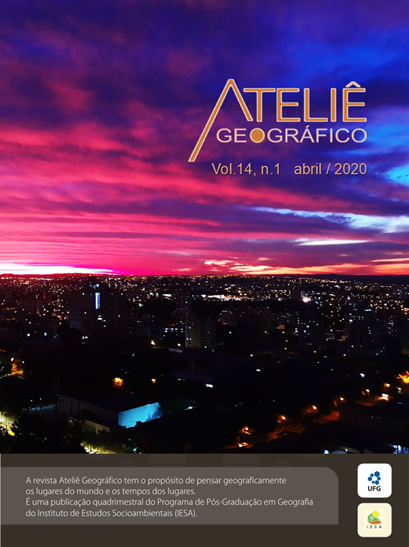Analysis of the landscape dynamics of the Nhecolândia Pantanal (Mato Grosso do Sul, Brazil)
DOI:
https://doi.org/10.5216/ag.v14i1.58415Abstract
The Pantanal of Nhecolândia is a sub-region of the Brazilian Pantanal whose socioenvironmental dynamics is marked by cattle breeding and the geosystemic relationships of humid areas, while also being an active depositional environment. The aim of the present study was to analyze the landscape dynamics of the Pantanal of Nhecolândia using the tripolar GTP method (geosystem, territory and landscape). To this end, land use and cover were analyzed during the rainy and dry seasons of 1987, 1995, 2005, and 2017, and the data were submitted to the techniques of Map Algebra, generating maps depicting seasonal spatio-temporal (SST)and historical spatio-temporal (HST) changes, which, respectively, illustrate the spatial changes caused by seasonal flooding and those resulting from the socio-environmental dynamics over the 30-year period (1987-2017). Analysis of the socioenvironmental conditions enabled the development of socio-environmental zoning and led to proposals for managing the four established zones: High Nhecolândia, Taquari-Negro, Low Nhecolândia, and Low Taquari.
Keywords: Taquari Megafan. Land Use and Cover. Socio-Environmental Zoning.
Downloads
Downloads
Published
How to Cite
Issue
Section
License
Autores que publicam nesta revista concordam com os seguintes termos:- Autores mantém os direitos autorais e concedem à revista o direito de primeira publicação, com o trabalho simultaneamente licenciado sob a Licença Creative Commons Attribution que permite o compartilhamento do trabalho com reconhecimento da autoria e publicação inicial nesta revista.
- Os autores não serão remunerados pela publicação de trabalhos na Revista Ateliê Geográfico. Além disso, os conteúdos publicados são de inteira e exclusiva responsabilidade de seus autores, ainda que reservado aos editores o direito de proceder a ajustes textuais e de adequação às normas da publicação.
- Autores têm permissão e são estimulados a divulgar seu trabalho online (ex.: em repositórios institucionais ou na sua página pessoal), já que isso pode gerar alterações produtivas, bem como aumentar o impacto e a citação do trabalho publicado (Veja O Efeito do Acesso Livre).


